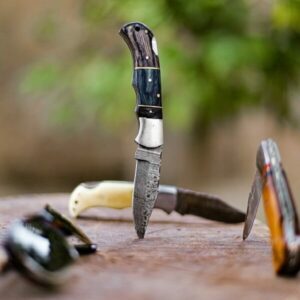Chisels are a great tool for carving wood. They can be used to create intricate designs or to remove large amounts of wood quickly. In this blog post, we will discuss the different types of chisels available, as well as some tips and tricks for using them effectively. We will also show you how to carve a simple design into a piece of wood.
The History Of The Chisel
The chisel has been used for centuries to carve wood. It was originally invented by the ancient Egyptians and was later popularized by the Romans. Chisels were typically made from bronze or iron and were used to carve sculptures and furniture.
Today, chisels are still used for carving wood, but they are also commonly used for carving stone and metal. There are a variety of different types of chisels available, each with its own set of unique benefits.
The Different Types Of Chisels
First, let’s discuss the different types of chisels available. There are three main types: carving, mortising, and bench. Carving chisels are designed for intricate designs, mortising chisels are used for cutting mortises (a hole in a piece of wood that is wider at the bottom than at the top), and bench chisels are used for general purpose carving and cutting.
Carving Chisels
Carving chisels are the most common type of chisel. They have a thin, sharp blade that is ideal for intricate designs. Carving chisels come in a variety of shapes and sizes, pick the ones that fit your needs.
Slick Chisel
A slick chisel is a type of carving chisel that has a thin, sharp blade and a smooth surface. This allows you to create very intricate designs. Slick chisels come in different sizes. The most common size is the ¼ inch slick chisel.
Skew Chisel
A skew chisel is a type of carving chisel that has a beveled blade. This allows you to create curved designs. Skew chisels come in different sizes. The most common size is the ¼ inch skew chisel.
Japanese Chisels
Japanese chisels are a type of carving chisel that is popular in Japan. They have a thin, sharp blade and a square handle. Japanese chisels come in different sizes. The most common size is the ¼ inch Japanese chisel.
Mortising Chisels
Mortising chisels are designed for cutting mortises. They have a wide, blunt blade that is perfect for removing large amounts of wood quickly. Mortising chisels come in different sizes. Choose the size that is best suited for the job at hand.
Butt Chisel
A butt chisel is a type of mortising chisel that has a blunt blade. It is perfect for removing large amounts of wood quickly. Butt chisels come in different sizes. The most common size is the ½ inch butt chisel.
Bench Chisels
Bench chisels are general-purpose chisels that can be used for carving and cutting. They have a wide, sharp blade that is perfect for most tasks. Bench chisels come in different sizes. The most common size is the ½ inch bench chisel.
Firmer Chisel
A firmer chisel is a type of bench chisel that has a very thick blade. It is perfect for removing large amounts of wood quickly. Firmer chisels come in different sizes. The most common size is the ¾ inch firmer chisel.
Paring Chisel
A paring chisel is a type of bench chisel that has a thin blade. It is perfect for delicate tasks such as carving and shaping wood. Paring chisels come in different sizes. The most common size is the ¼
Bevel Edge Chisel
A bevel edge chisel is a type of bench chisel that has a beveled edge. This allows you to create more intricate designs. Bevel edge chisels come in different sizes. The most common size is the ½ inch bevel edge chisel.
Masonry Chisel
Masonry chisels are designed for cutting stone. They have a wide, blunt blade that is perfect for removing large amounts of stone quickly. Masonry chisels come in different sizes. The most common size is the ¾ inch masonry chisel.
Choose The Right Chisel For Your Needs
When selecting a chisel, you need to consider the task that you will be using it for. If you are unsure which chisel to use, ask your local hardware store employee for help. They will be able to recommend the best chisel for your needs.
How To Use A Chisel
Now that we have discussed the different types of chisels available, let’s discuss how to use them effectively. Here are a few tips:
- Always use a sharp blade – a dull blade will not cut the wood properly and can cause injuries.
- Be careful when using chisels – they can be dangerous if not used correctly.
- Hold the chisel with your dominant hand and place your thumb on the top of the blade.
- Use your other hand to hold the wood in place.
- Apply pressure with your thumb and use a slicing motion to cut the wood.
- Be careful not to apply too much pressure, as this can cause the chisel to slip and injure your hand.
How To Carve A Design Into Wood
Now that we have discussed how to use a chisel, let’s show you how to carve a simple design into a piece of wood. Here are the steps:
- Draw the design you want to carve onto the wood with a pencil.
- Use a carving chisel to cut out the outline of the design.
- Use a different type of chisel (e.g. a bench chisel) to carve the interior of the design.
- Use a sharpening stone to sharpen the blade of the chisels when necessary.
Carve A Simple Design
Now that we have covered some of the basics, let’s try carving a simple design into a piece of wood. First, choose a piece of wood that is about 12″ long and at least ½” thick. Draw the design you want to carve onto the wood with a pencil.
Then, use a chisel to carve away the wood around the lines of the design. Be sure to keep the chisel sharp, and use a mallet to strike the end of the chisel. Carve slowly and carefully, making sure to keep the lines of the design clean.
Here is a video that shows how to carve a simple design into wood using a chisel:
[youtube link]
Keep Your Tool Sharp
When using a chisel, it is important to keep the tool sharp. A sharp chisel will cut more cleanly and be less likely to tear the wood. To sharpen a chisel, use a honing guide or honing stone. First, clamp the honing guide to the workbench. Then, sharpen the bevel of the chisel with a honing stone. Be sure to keep the angle of the honing stone consistent as you sharpen.
Use A Mallet
When carving wood, it is important to use a mallet instead of your hand. This will help to create more control and avoid damage to the chisel. Hold the chisel with your non-dominant hand, and use your dominant hand to hold the mallet. Strike the end of the chisel with a light but firm blow. Be sure to keep your fingers clear of the blade.
Chisel Cut Types
When using a chisel to carve wood, there are several types of cuts you can make. The most common are the straight cut, the bevel cut, and the V-cut.
The Straight Cut
This is the simplest type of cut to make. To make a straight cut with a chisel, hold the chisel at a right angle to the wood and use a mallet to strike it firmly. This will create a clean, straight cut.
The Bevel Cut
To make a bevel cut, hold the chisel at an angle to the wood and use a mallet to strike it firmly. This will create a beveled edge on the wood.
The V-cut
To make a V-cut, hold the chisel so that it forms a V-shape with the wood and use a mallet to strike it firmly. This will create a V-shaped groove in the wood.
The Firm Cut
When using a chisel to carve wood, it’s important to make sure you use the correct cut for the type of wood you’re carving. In general, you should use a firm cut when carving hardwoods and light cut when carving softwoods.
The chopping cut
The chopping cut is used for removing small amounts of wood. To make a chopping cut, hold the chisel with your dominant hand and place your thumb on the back of the blade. Use your other hand to guide the workpiece.
Curving Curves
When carving curves, hold the chisel at a slight angle and use a slicing motion. When carving straight lines, hold the chisel perpendicular to the workpiece and use a chopping motion.
Using the Wrong Cut
If you try to use a firm cut on softwood, you may end up splitting the wood. If you try to use a light cut on hardwood, you may not be able to carve it at all.
Sharpening Your Chisel
It’s important to keep your chisel sharp so that it can cut cleanly through the wood. To sharpen your chisel, hold it at a right angle to the grinding wheel and use light pressure to slowly grind away the bevel. Be careful not to grind away too much of the bevel or you’ll lose the sharp edge.
Keep your chisels sharp by honing them regularly on a sharpening stone. Start with a coarse grit stone and then progress to a finer grit stone. Always hone in the same direction as the bevel of the blade.
When you’re finished sharpening, hold the chisel up to a light and make sure that the edge is still sharp. If it’s not, sharpen it some more.
Keep Your Blade From Sticking to the Wood
Use a lubricant, such as beeswax or mineral oil, to keep your chisels from sticking to the workpiece. Apply a small amount of lubricant to the cutting edge of the chisel and then rub it into the bevel with your thumb. Wipe off any excess lubricant with a cloth.
Safety Rules Before Working With A Chisel
When using a chisel to carve wood, always take precautions to avoid injury. Wear safety glasses and a dust mask to protect your eyes and lungs from flying debris. Make sure you are aware of your surroundings and don’t swing the chisel around recklessly. Never use a chisel when you’re feeling angry or frustrated, as this can lead to accidents.
For Conclusion
The chisel is a versatile tool that can be used for a variety of tasks, including carving wood. When using a chisel to carve wood, it’s important to pick the right chisel for your project and use the correct cut for the type of wood you’re working with. don’t forget to maintain your chisel and keep your blade sharp. Take precautions to avoid injury, and always work in a safe and controlled manner. Happy carving!









